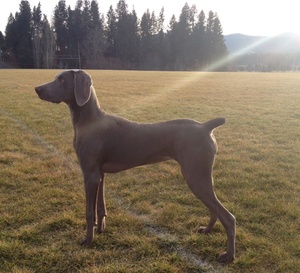Nicknamed the “Grey Ghost,” weimaraners have a distinctive coat that gives them a regal and instantly recognizable appearance. Their short, smooth coat gray coat ranges in shades from charcoal to silver and their eyes (typically amber, gray or blue-gray) maintain the pallid look of the dog.
This majestic and unique coat color is draped around an athletic and muscled frame consistent with the look of other pointers – albeit it with a docked tail – and conveys the appearance of speed, stamina and grace. The breed standard mandates that they max out at 27 inches in height and 80 pounds in weight, with females being smaller. Recognized by the United Kennel Club, long-haired and “blue” weimaraners are considered to be disqualifications in the conformation ring by the American Kennel Club.
The weimaraner was originally developed as an all-around hunting dog for nobility in Germany during the early 19th Century. It was expected to hunt boar, bear and deer, but as big game became scarce in Europe it was used to hunt smaller game such as foxes and rabbits. In modern-day America, the weimaraner is primarily used as an upland-game-bird dog to hunt pheasant, quail, chukar, grouse and the ...









